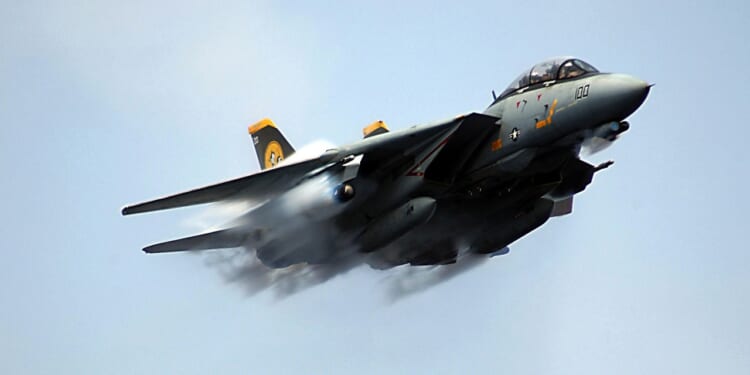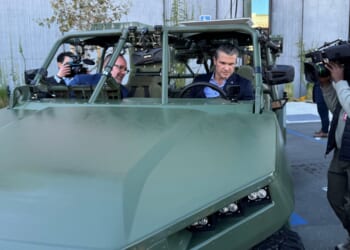Ultimately, the economics of the mighty F-14 no longer made sense in the post-Cold War unipolar era.
For a generation, the Grumman F-14 Tomcat defined American naval airpower. With swing wings, twin tails, and gorgeous lines, the F-14 became a Cold War icon, one of the most transcendent military aircraft ever thanks to Tom Cruise’s turn behind the controls in 1986’s highest grossing film, Top Gun. Yet by 2006, the Navy had retired the F-14 entirely. The reason was not strictly related to the F-14’s capabilities; she was still an impressive platform, even if aging. Instead, the F-14’s cost, complexity, and obsolete mission profile in America’s unipolar era pushed the Navy away from the vaunted warplane.
About the F-14 Tomcat
- Year Introduced: 1974
- Number Built: 712 (all variants)
- Length: 62.8 ft (19.1 m)
- Wingspan: 64.1 ft (19.5 m) extended; 38.2 ft (11.6 m) swept
- Weight (MTOW): ~74,350 lb (33,720 kg)
- Engines:
- F-14A: Two Pratt & Whitney TF30-P-414A afterburning turbofans (~20,900 lbf each with afterburner)
- F-14B/D: Two General Electric F110-GE-400 afterburning turbofans (~27,000 lbf each with afterburner)
- Top Speed: Mach 2.34 (~1,544 mph / 2,485 km/h) at altitude
- Combat Radius: ~500–575 mi (805–925 km) depending on profile
- Service Ceiling: ~50,000 ft (15,240 m)
- Loadout: One 20mm M61A1 Vulcan cannon; up to 6 AIM-54 Phoenix, 4 AIM-7 Sparrow, and 2 AIM-9 Sidewinder missiles (or air-to-ground stores on later “Bombcat” configurations); maximum external load ~14,500 lb (6,600 kg)
- Aircrew: 2 (Pilot and Radar Intercept Officer)
In the 2000s, the F-14 Was the Right Plane at the Wrong Time
The F-14 was designed for one very specific mission profile: defending US carrier strike groups against Soviet bombers armed with long-range anti-ship missiles. Everything about the F-14 reflected that singular purpose. It was a large aircraft, measuring nearly 63 feet long, capable of flying Mach 2.3, and able to carry the Phoenix missile (a 1,000 pound weapon with a range beyond 100 miles). For two decades, the F-14 stood guard over the fleet, the pinnacle of range and power.
But the qualities that made the F-14 so impressive also made it difficult to sustain. The aircraft was a maintenance hog; the variable-sweep wings, hydraulic systems, and analog electronics required constant attention. Each flight hour demanded between 30 and 50 man-hours of maintenance—several times more than its eventual successor, the F/A-18 Hornet.
By the 2000s, the youngest F-14 airframes were approaching 20 years old. Two decades is a long time for any aircraft—especially one subjected to the rigors of carrier operations. Cracks, corrosion, and fatigue plagued the F-14 fleet. Often, to keep F-14s airworthy, maintenance crews would need to rebuild the aircraft piece by piece, and because the parts were so old, many had to be fabricated from scratch through custom work—an extremely costly and time-intensive proposition.
Why Did the Navy Replace a Great Plane with a Lesser One?
Ultimately, the economics of the plane no longer made sense. The Navy could operate two or three F/A-18s for the cost of a single F-14. And while the F/A-18 was slower and had a smaller combat radius, she was also digital, reliable, and multirole—capable of dropping bombs and replacing the F-14 as carrier defender.
With the end of the Soviet Union, without the need for a dedicated fleet-air-defense fighter, the F-14’s mission had vanished. And so the Navy pivoted towards a more versatile platform, rather than one that excelled in pure performance.
That’s the irony of the F-14. Her performance rivaled (or exceeded, in some respects) that of her replacement. But the age of raw performance seemed to die with the Soviet Union, giving way to the age of role consolidation and efficiency.
The F-14 is still, technically, in service—with Iran, who struggles to keep their fleet airworthy. The forty-year-old Iranian fleet is increasingly hard to maintain, especially considering that when the Navy retired its F-14s, it went so far as to destroy all spare parts to ensure that none could make their way to Iran. It is hardly a fitting end for the Navy’s most celebrated fleet defender to atrophy slowly in the Persian desert.
About the Author: Harrison Kass
Harrison Kass is a senior defense and national security writer at The National Interest. Kass is an attorney and former political candidate who joined the US Air Force as a pilot trainee before being medically discharged. He focuses on military strategy, aerospace, and global security affairs. He holds a JD from the University of Oregon and a master’s in Global Journalism and International Relations from NYU.
Image: Wikimedia Commons.

















